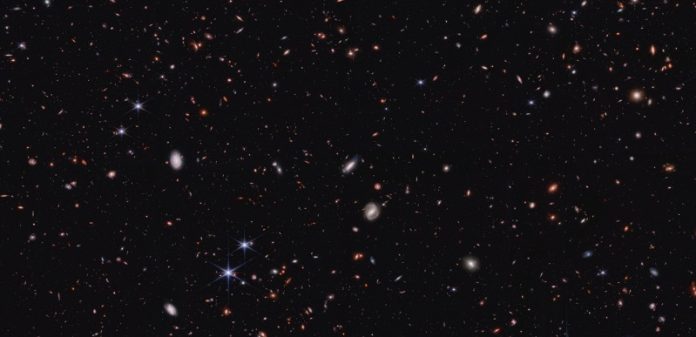
When astronomers first looked at distant galaxies in the early universe using NASA’s James Webb Space Telescope, they were shocked by what they saw.
Instead of finding small, young galaxies, they discovered what seemed to be massive, mature galaxies, much larger than expected.
This surprising discovery led some researchers to question the standard model of cosmology—the theory that explains the universe’s structure and how it has evolved since the Big Bang.
However, new research led by Katherine Chworowsky, a graduate student at the University of Texas at Austin, suggests that these early galaxies might not be as massive as they first appeared. The key lies in black holes.
The study, published in The Astrophysical Journal, found that some of the galaxies in the early universe have black holes at their centers that are consuming large amounts of gas.
As the gas falls into these black holes, it heats up and emits light, making the galaxies look much brighter and larger than they really are.
This extra brightness can make the galaxies appear to have more stars and, therefore, more mass than they actually do.
When Chworowsky and her team removed these overly bright galaxies, called “little red dots” due to their small size and red color, from their analysis, the remaining galaxies fit within the predictions of the standard model of cosmology.
This means that the universe’s structure and evolution aren’t as mysterious as first thought.
“So, the bottom line is there is no crisis in terms of the standard model of cosmology,” said Steven Finkelstein, a professor of astronomy at UT Austin and a co-author of the study.
“Our results show that the standard model still holds strong.”
However, one mystery remains: there are still about twice as many massive galaxies in the early universe than expected.
One possible explanation is that stars formed more quickly in the early universe than they do today. Because the early universe was denser, it may have been harder for gas to escape during star formation, allowing the process to go faster.
Further evidence from the James Webb Space Telescope supports the idea that at least some of the light from these “little red dots” is coming from gas swirling around black holes, rather than from stars.
This reinforces Chworowsky’s conclusion that these early galaxies are not as massive as first thought.
However, more observations are needed to fully understand how much of the light comes from stars versus gas around black holes.
Although this study resolves some questions, it also raises new ones. As Chworowsky put it, “Not everything is fully understood.
That’s what makes doing this kind of science fun, because it would be terribly boring if one paper figured everything out and there were no more questions to answer.”



